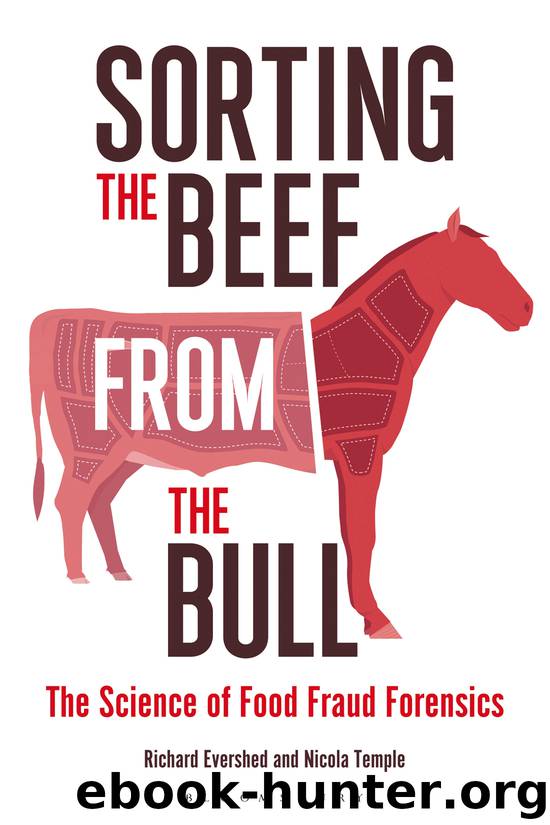Sorting the Beef from the Bull by Richard Evershed & Nicola Temple

Author:Richard Evershed & Nicola Temple
Language: eng
Format: epub
Publisher: Bloomsbury Publishing
Substitutions aren’t limited to highly processed meat
The techniques of the fraudsters are now sophisticated enough that substitutions can happen beyond the minced and processed meats. Let’s return to the example from China of fake mutton. Thinly shaved mutton slices are a popular hotpot ingredient. There have now been several scams unveiled in China that have involved the sale of fake mutton; one operation, raided in January 2013, had 40 tonnes of fake mutton and another 540 tonnes of materials to make more. Allegedly, rat, mink, fox and duck meat have all been used as the base for this fake product. These meats are apparently soaked in a cellulose gum (sodium carboxymethyl cellulose), which is commonly used in food manufacturing to extend shelf life, improve freeze/thaw stability and help bind water. In the making of fake mutton, this process allows the meat to take on more water and therefore increase its apparent weight. Food colouring is used to provide the ideal shade of mutton, and food adhesives (more on meat glue later) are used to bind the fake meat with real mutton fat. The end product is a passable, but not indistinguishable, version of mutton. What sets the fake apart is that the fat is not marbled throughout the meat as would be the case naturally. The fat and meat are quite separate and when it is thawed or cooked, the adhesive fails and one is left with fragments of fat and fragments of meat.
Despite what seems like an arduous process, making the fake mutton is worth the effort. The fraudsters can sell it wholesale to restaurants for about £2.12/kg (US$1.45/lb) less than the real thing, allowing them to undercut competitors selling real mutton. Forty tonnes of fake mutton would turn a profit of about £128,000 (US$192,000) – nearly 23 times the average annual salary in China for 2014.
In September 2013, police confiscated 20,000kg (44,000lb) of pork masquerading as beef from a factory in north-west China. Not mince, not sausages, not even thinly sliced ‘mutton’, but whole cuts of pork that had been made to look like beef. One wouldn’t think it was possible. The pork is mixed with beef extract and a glazing agent and left to sit for ninety minutes. When cooked, the meat takes on a dark beef-like appearance rather than the characteristic white pork colour. The beef extracts even give it the beefy aroma one would expect. Though it may be more difficult to swindle people over whole cuts of meat, this shows it’s not impossible.
If one end of the spectrum is to transform a pork chop into a steak, the other end is to change things at a microscopic scale. In 2001, the UK FSA released results of an investigation that was carried out jointly with 22 local authorities. They tested 68 samples of chicken breasts that were being sold to the catering trade and found that more than half of them were mislabelled, including some that contained undeclared hydrolysed protein. Hydrolysed protein is protein that’s been broken down into smaller segments known as peptides, usually using an enzyme.
Download
This site does not store any files on its server. We only index and link to content provided by other sites. Please contact the content providers to delete copyright contents if any and email us, we'll remove relevant links or contents immediately.
| Cheese & Dairy | Chocolate |
| Fish & Seafood | Fruits |
| Herbs, Spices & Condiments | Meat & Game |
| Natural Foods | Pasta & Noodles |
| Potatoes | Poultry |
| Rice & Grains | Vegetables |
The Sprouting Book by Ann Wigmore(3564)
Better Homes and Gardens New Cookbook by Better Homes & Gardens(3551)
Trullo by Tim Siadatan(3400)
Super Food Family Classics by Jamie Oliver(3385)
Hedgerow by John Wright(3322)
Panini by Carlo Middione(3296)
Bread Revolution by Peter Reinhart(3102)
Sauces by James Peterson(3072)
Jam by Jam (epub)(3051)
Ottolenghi - The Cookbook by Yotam Ottolenghi(2903)
Oh She Glows Every Day by Angela Liddon(2752)
My Pantry by Alice Waters(2581)
Hot Sauce Nation by Denver Nicks(2467)
Veg by Jamie Oliver(2456)
The Culinary Herbal by Susan Belsinger(2454)
Meathooked by Marta Zaraska(2241)
Wanderlust by Jeff Krasno(2239)
The Art of Making Gelato by Morgan Morano(2234)
Basic Illustrated Edible and Medicinal Mushrooms by Jim Meuninck(2197)
